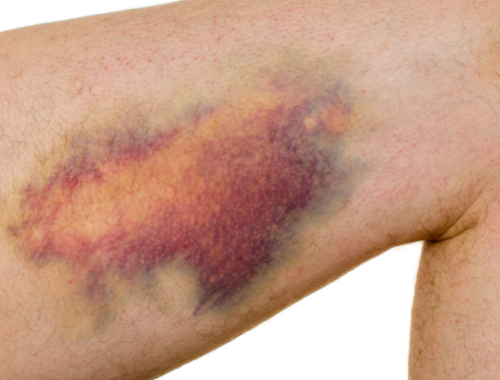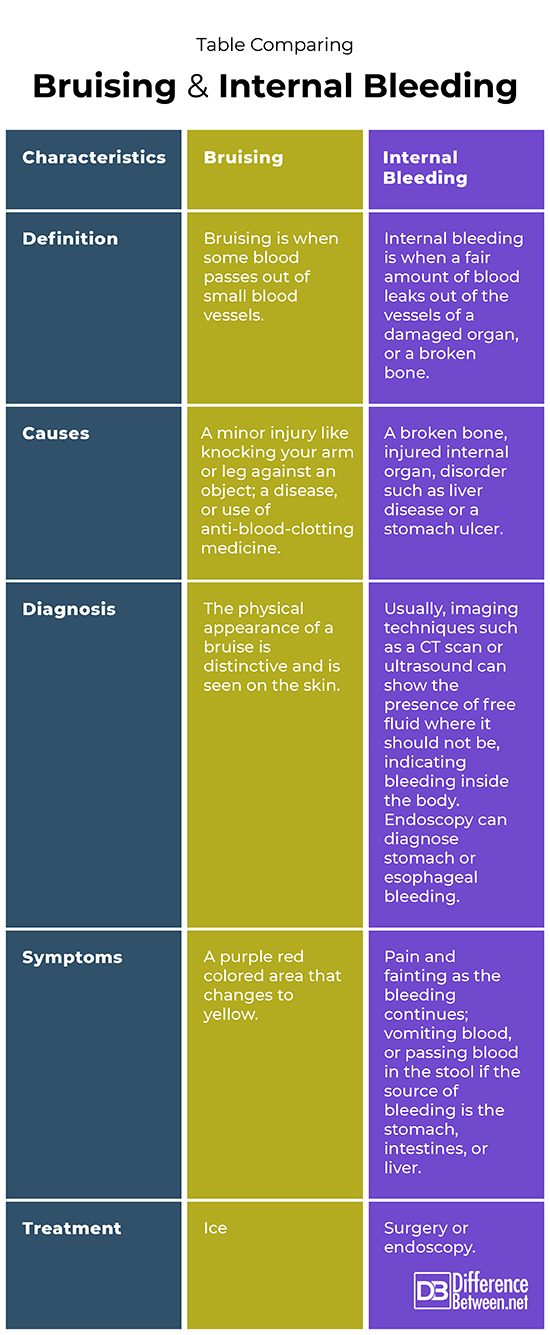Difference Between Bruising and Internal Bleeding
Bruising is a result of some blood moving out of blood capillaries that have been damaged. Internal bleeding is bleeding that occurs inside the body.

What is Bruising?
Definition:
Bruising is when some blood moves out of blood vessels due to some sort of injury or disease process.
Causes:
Bruising can be caused by certain medical problems, anti-clotting medicine, or an injury. A person may bump their arm or leg resulting in a bruise forming.
Diagnosis and symptoms:
A physical exam will diagnose a bruise because it can be seen on the skin. A bruise appears as a purple-colored area that in time changes to a yellowish color. Bruises that happen all the time can mean you have a blood clotting condition or other illness.
Treatment:
Ice packs are often used to help heal the bruise because the ice helps reduce the inflammatory response. A bruise should heal on its own, if not you should see your doctor.

What is Internal bleeding?
Definition:
Internal bleeding is when blood is lost from a blood vessel. It is normally when a fairly severe injury occurs causing a lot of bleeding.
Causes:
One of the most common reasons for internal injury is blunt force trauma that injures organs. A motor vehicle accident, for instance, often causes injury to internal viscera resulting in bleeding. Broken bones, particularly in the pelvic region, can result in heavy internal bleeding. Certain medical conditions such as stomach ulcers and liver disease can also result in internal bleeding.
Diagnosis and symptoms:
A patient with internal bleeding will feel pain when the hemorrhage increases. A physical exam and imaging studies such as CT scans and ultrasounds can show the presence of blood inside the body where an injury has occurred. Endoscopy can show bleeding in the stomach and esophagus. Patients with gastrointestinal bleeding may vomit blood or pass blood in the stool.
Treatment:
Surgery may be needed where an organ is injured or bone is broken causing hemorrhage. Endoscopy can be used to stop bleeding in the stomach or from esophageal varices (in the case of liver disease).
Difference between Bruising and Internal bleeding?
Definition
Bruising is when some blood passes out of small blood vessels due to some injury. Internal bleeding is when a fair amount of blood leaks out of the vessels of a damaged organ, or a broken bone.
Causes
A bruise is most often from a small injury like bumping your arm but can be due to disease or using anti-clotting medicine. Internal bleeding is from a traumatic injury or a disorder such as a stomach ulcer or liver disease.
Diagnosis
A doctor can easily diagnose a bruise by its purple appearance. Internal bleeding is best diagnosed using imaging studies like CT scans or ultrasound and by endoscopy.
Symptoms
A bruise appears purple and red at first and then turns yellow as it heals. Internal bleeding eventually shows symptoms such as fainting and weakness and pain. Vomiting blood and passing blood in the stool are also symptoms of internal bleeding.
Treatment
A bruise usually heals by itself but ice can help stop the inflammation. Internal bleeding usually requires surgery or endoscopy to stop the bleeding.
Table comparing Bruising and Internal bleeding

Summary of Bruising Vs. Internal bleeding
- Bruising is when a minor injury happens causing some blood to spill out of some small blood vessels.
- Internal bleeding is when an injury inside the body causes hemorrhage.
- A bruise is usually a small injury while internal bleeding occurs from a substantial injury such as a broken pelvis or lacerated liver.
- A bruise heals on its own in time.
- Internal bleeding often requires surgical intervention to stop the hemorrhage.
FAQ
How can you tell if a bruise is internal bleeding?
If a very large bruised region is present along with pain in the area of injury, then internal bleeding is possible. The pain is great and the person also often faints or is weak if there is internal bleeding.
What are the first signs of internal bleeding?
Weakness and fainting are often the first signs of internal bleeding. You may also experience nausea and dizziness. Other symptoms depend on the source of bleeding. For instance, blood in the stool or vomit indicates gastrointestinal bleeding.
Is bruising considered bleeding?
It is a form of bleeding in the sense that blood has leaked out of injured blood vessels.
How do you know when a bruise is serious?
A bruise is serious if the area is very painful and swollen. Minor injuries should get better quite quickly but if the pain does not improve and worsens, then a doctor should be consulted.
Can you be bleeding internally and not know it?
Internal bleeding can at first go unnoticed but as it worsens, symptoms such as pain and fainting will occur. Fainting is often due to a drop in blood pressure as blood is lost. Pain is also likely to worsen if an organ is injured and as blood presses on structures inside the body.
- Difference Between Rumination and Regurgitation - June 13, 2024
- Difference Between Pyelectasis and Hydronephrosis - June 4, 2024
- Difference Between Cellulitis and Erysipelas - June 1, 2024
Search DifferenceBetween.net :
Leave a Response
References :
[0]Kaji, Amy H. “Internal bleeding”. Merck Manual, 2020, https://www.msdmanuals.com/home/injuries-and-poisoning/first-aid/internal-bleeding
[1]Skow, Glenn. "Easy Bruising, Low Platelets, Recent Coldlike Illness."
[2]Stephenson, Terence, and Yvona Bialas. "Estimation of the age of bruising." Archives of Disease in Childhood 74.1 (1996): 53-55.
